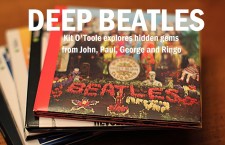As “Sun King” quietly fades, a drum kickstarts this darkly humorous track: “Mean Mr. Mustard,” a John Lennon composition dating to 1968. His own harshest critic, Lennon later labeled it a “piece of garbage.” However, it contains a classic Lennon technique: creating eccentric characters who display outrageous — even offensive — traits.
“Mean Mr. Mustard’s” origins trace back to the Beatles’ stay in India. Although the Beatles were there to study transcendental meditation and spirituality, the trip also fueled their creativity. Each member brought numerous tracks for the White Album sessions, leaving the group with the unenviable problem of choosing the best tracks for the two-disc project.
One of those extra songs, “Mean Mr. Mustard” was inspired by a newspaper story; this would mark yet another time that Lennon drew from a news story for his songwriting. In a 1980 interview, he claimed that he’d read a story about “this mean guy who hid five-pound notes, not up his nose but somewhere else. No, it had nothing to do with cocaine.”
The Beatles recorded a demo of the track at George Harrison’s bungalow in Esher, Surrey in May 1968. This stripped-down take, above, features acoustic guitar and Lennon’s double-tracked voice. Lacking harmonies, the early “Mr. Mustard” also contained no ending. Toward the end, Lennon starts repeating the title phrase and ad-libbing phrases like “such a dirty dirty Mean Mr. Mustard.” Although frequently bootlegged, the demo later surfaced on the Anthology 3 collection.
The group returned to the track in January 1969 during the infamous “Get Back” sessions. In this version, embedded below, Lennon’s electric piano prominently features, while Harrison contributes new guitar licks. Note that one lyric differs here; in Anthology, Lennon explains that “I said ‘his sister Pam’ — originally it was ‘his sister Shirley’ in the lyric. I changed it to Pam to make it sound like it had something to do with [‘Polythene Pam’].” Frequently Lennon ad-libs in a similar manner to the 1968 demo, along with a bit of scatting. Clearly, the Beatles were still playing with the track, unsure how to end it.
After the “Get Back” project was shelved, the group reunited for the Abbey Road album and fused the fragments for the medley. On “Mean Mr. Mustard,” Lennon played guitar, maracas, and sang lead; McCartney provided crucial harmony vocals, bass, and perhaps piano (it is unclear whether he or Lennon played this); Harrison contributed lead guitar; and Ringo Starr, of course, played drums and tambourine. They completed 35 takes of the rhythm track on July 24 — take 35 was deemed the best — then finished overdubs July 25 and 29.
Now comes a crucial point in Beatles history: originally “Her Majesty” was to have been sandwiched between “Mean Mr. Mustard” and “Polythene Pam.” Ultimately, McCartney vetoed the idea, believing the sequence just did not work. So-called “outfakes” that later emerged recreated this order, demonstrating the jarring effect. However, before making this decision, they altered the ending of “Mean Mr. Mustard” to smoothly transition into “Her Majesty.” In the July 1969 version, embedded below, listen for the drum crash at the end of the track. The crashing chord at the beginning of “Her Majesty” derives from this early experiment with the medley sequence.
In Alan Pollack’s excellent “Notes On” series, he classifies “Mean Mr. Mustard” as a bridge of sorts, a way to link two disparate songs. “Following on the heels of the more substantial and self-contained previous two songs this one critically needs to pick up the pace and get the show on the road, medley-wise,” he posits. “In this case, the short track length, incomplete form, and the tighter, smoother coupling of the track at both ends to the songs that surround it seem as a group of factors to work out just right.” Initially the tempo recalls “Sun King,” but ultimately speeds up to introduce “Polythene Pam.”
Lyrically, the song reflects Lennon’s unique gift for portraying outsiders, sometimes with unattractive traits (see “Nowhere Man,” “Sexy Sadie,” “A Day in the Life,” and “Dr. Robert,” among many others). He points listeners to a homeless man who “sleeps in a hole in the road.” While he supposedly saves money to buy clothes, the phrase “keeps a ten bob note up his nose” suggests gluttony and greed. In contrast, his sister Pam is employed, a “go-getter,” and higher class.
She tries exposing her brother to the elite by taking him out “to look at the Queen,” but he fails to emulate her civility. Instead, Mr. Mustard “shouts out something obscene,” proving that he will forever dwell in his den of iniquity. He’s “such a dirty old man,” “such a mean old man,” and remains so despite his sister’s best efforts. It would have been interesting if Lennon had fleshed out the rest of the song; would he have changed the Pam character? As in his later work, would he have criticized her for working too hard, wearing blinders to the world around her?
In 1994, McCartney discussed the track, calling it “very John. I liked that. A nice quirky song.” While quirky, it also stands as a chugging rocker that contains tight harmonies and memorable lyrics. “Mean Mr. Mustard” serves as a crucial transitional tool to merge two disparate songs — “Sun King” and “Polythene Pam” — in a way that only the Beatles could execute.
- How John Lennon Came Roaring Back on the Beatles’ White Album - November 22, 2023
- Five ‘With the Beatles’ Deep Cuts That Illustrate Their Lasting Debt to R&B - November 20, 2023
- Five Must-Hear Deep Cuts from the Beatles’ ‘Past Masters’ - March 7, 2023


